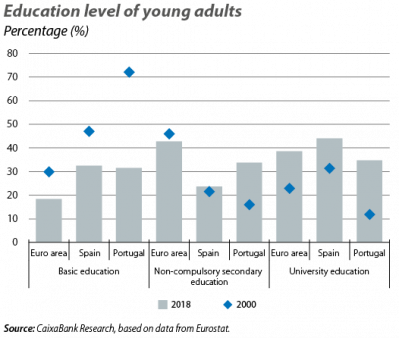Young adults in the 21st century, a different approach to life?
• The current generation of young adults is very different from that of their parents: better prepared, more diverse and with a different set of values.
• Young adults are delaying key milestones such as leaving home, living as a couple and having children, and there is greater diversity in the type of households.
• There are essentially two major forces behind these changes: cultural transformations and the economic environment.
• The cyclical factors that have delayed the decisions taken by today’s young adults will lose intensity over the coming years. However, the underlying forces, such as secularisation and economic transformations, will remain ever present and suggest that, broadly speaking, the behavioural changes we see among young people are here to stay.
The young adults of today: a different generation
Around 11.2 million Spaniards and 2.4 million Portuguese today are young adults, the population between 20 and 39 years of age that represents the first phase of adulthood (those who have reached «full growth or development» according to the definition by the Spanish Royal Academy). In biological terms this development refers to full reproductive capacity, although in a broader sense it refers to independent decision-making. This population takes the first decisions of the adult phase in life, covering further education (master’s degrees, postgraduate courses, etc.), leaving home, forming a family, parenthood, as well as working in a phase in life that is key for their professional development. It is for all these reasons that the future of our society is influenced by the decisions taken by young adults. In this article, we will analyse the socio-demographic changes taking place in our young adults, as well as the factors that are driving them to these changes and the consequences for society as a whole.
Young adults represent a significant portion of the working-age population. In 2018, they made up 37% of the working-age population in Spain (35.8% in Portugal), a significant portion but less than at the beginning of the century, when they accounted for almost half of the working-age population in Spain (48%) and somewhat less in Portugal (44.8%). In the next decade, the weight of young adults in the total population is expected to remain at a similar level, representing 36% of the working-age population in both Spain and Portugal in 2030.
Besides the significant portion of the working-age population that they represent, the current generation of young adults is very different from previous ones. In terms of education, young adults are now a thoroughly prepared generation. In both Spain and Portugal, more than two-thirds have studies beyond the basic education level.1 This is in stark contrast to the situation in the year 2000, when 47% of young adults in Spain and 72% of those in Portugal only possessed the basic level of education (see first chart). Furthermore, the attainment of education has gone further still, with the proportion of young adults who hold higher university studies and undertake master’s and doctoral degrees increasing significantly. Spain even has a higher proportion of university students than the euro area average, in contrast with the situation for secondary education (including vocational training), which is less widespread in Spain than in the euro area as a whole.
Young adults today are also a more diverse and more mobile generation. One in every five young adults living in Spain in 2018 was born outside the country (in the year 2000 they represented only 5.1% of the population in this age group). This diversity of origin is also well above the average for the population as a whole (9.8%), since the immigration flows are concentrated in the ages of greater participation in the labour market (as is the case for those aged 20 to 39). Out of every four young immigrants, one was born in another EU country and three, outside the Union, above all in Latin America and Morocco. In Portugal, 9.2% of young people were immigrants in 2018, also well above the population average (4.1%).
On the other hand, young natives are more mobile than before. Driven in part by the financial crisis, more young Spaniards left the country starting in 2009, reaching a peak of 30,000 young people in 2015 and falling to 23,000 in 2017.2 Since the start of the economic recovery, however, the number of young natives returning to Spain (see second chart) has been clearly on the rise. All in all, these figures represent a smaller percentage of the total population of young adults (in 2017, departures represented 0.2% of the population aged 20 to 39 and arrivals, 0.1%).
In addition, the current generation of young adults has a very different set of values from their parents (see third chart). Both Spain and Portugal are much more secular countries than just a few years ago. Religious sentiment has fallen markedly among young adults and to a far greater extent than in the rest of the euro area (which was already more secular). In addition, young people place more importance on values such as gender equality. For instance, more and more individuals believe that employment for men should not be given priority over employment for women, an opinion that was not so widespread a few years ago. Moreover, young adults are concerned about other issues such as climate change, particularly in Spain and Portugal.
Given these changes, it is not surprising that the current generation of young adults behaves very differently to past generations. In particular, they delay key plans which in the past had defined this stage in life, such as leaving home, living with a partner or parenthood. For example, in Spain and Portugal, nearly two-thirds of young people still live with their parents,3 percentage that has increased significantly in both countries and is well above the euro area average (see fourth chart).
As we discuss later, there are many factors causing young people to delay leaving home. The increased secularisation and individualism of our societies can lead to a relaxation of the social norms relating to when and in what order key milestones like marriage or parenthood take place, but these are also influenced by economic factors. The result is that Spaniards on average marry around 7 years later than they did in 1990 (at 35 years of age for men and 33 years of age for women). In Portugal, men marry at 32 years of age on average and women at 30.4 years, around 6 years later than in 1990. Indeed, this is a trend that can be seen in most advanced countries.
This change has major implications given that, normally, living as a couple favours a more stable lifestyle and the taking of decisions that entail greater long-term commitment. Thus, one characteristic of today’s young adults that has significant social consequences is the delay in the age at which people have their first child. This has risen from 28 in 1995 to 31 in 2016 for Spanish and Portuguese women (see fifth chart) and is leading to a reduction in the number of children being born, which was already low in both countries. Specifically, in 2016, for every 1,000 women aged between 20 and 39, 117 children were born in Spain and 125 in Portugal, far below the 157 born in Germany or the 180 in France.
In addition, there is greater diversification in the type of households. In both Spain and Portugal there is an increase in the proportion of couples without children (which represent 22% and 24% of the total number of households, respectively), as well as single parent households (representing 3% in Spain and 4% in Portugal). This greater diversification in the types of household seems to be even more marked among individuals with lower incomes.4
What lies behind the new profile of young adults?
It is time to analyse what has led today’s young adults both to postpone leaving home and starting a family and to form more diverse household structures. The nature of these causes will give us clues about how temporary or permanent these changes will be.
There are essentially two major forces that have shaped the behaviour of young adults in recent decades: cultural transformations and the economic environment. This is the assessment drawn by studies like the one by Matthias Studer and his co-authors,5 which shows that both the shift towards greater secularisation and developments in the labour market have contributed to changes in the formation of households among young adults. In the same vein, Daniel Cooper and María José Luengo-Prado,6 economists from the Federal Reserve Bank of Boston, document that much of the delay in young people leaving home and becoming independent can be put down to three key economic variables (regional unemployment rate, the person’s employment status and the regional ratio between the price of housing and the income of young people).7 On the other hand, both Zachary Bleemer and his co-authors8 and Frederick Furlong9 show that, in the US, the impact of the great recession of 2007-2009, the increase in the cost of housing and the higher cost of studies have contributed to the delay in people leaving home.
In cultural terms, trends such as the increasing secularisation of society and other changes in values have led experts to postulate the hypothesis that advanced economies are experiencing a second demographic transition.10 According to this hypothesis, since the 1960s individuals’ preferences have evolved towards values that place greater importance on people’s self-realisation and individual autonomy. Thus, societies exhibit less willingness to take decisions that entail a long-term commitment. In other words, whereas the first demographic transition was characterised by a decrease in mortality and fertility rates, these changes of values lead to a second transition characterised by a reduction in marriages, an increase in divorces, a postponement of when people have children and a reduction in the number of children being born.
With regard to changes in the economic environment, we must distinguish between phenomena of a cyclical nature and underlying economic transformations. If we focus on the former, the young adults of today are a generation marked by the economic recession that began in 2008: they have had to take their first big decisions as adults (such as the desired level of studies, entering the labour market and starting a family) at the most turbulent economic time in recent decades. This recession particularly penalised young workers, who suffered a bigger rise in unemployment, had greater difficulties in getting a stable job and faced a bigger drop in their incomes. For instance, between 2008 and 2016, the average wage in Spain fell by 14.9% for workers aged between 20 and 24 and by 8.9% for those aged 25 to 29 (compared to a cumulative increase of 5.8% for workers of all age groups as a whole).11 In addition, the unemployment rate among Spanish workers aged 20 to 39 reached a peak of 30% in 2013, with 58% long-term unemployment in this age group (peak registered in 2014) and an incidence of temporary employment above that of the rest of the population. These figures have improved since then, but they remain at relatively high levels.12 In fact, the recession will probably have long-lasting effects on the incomes of the current generation of young adults: several studies have shown that the conditions under which one enters the labour market (type of contract, salary, sector, etc.) are slow to fade and have an impact on labour conditions well into the future.13 Finally, compounding these difficulties in the labour market is the significant rise in the cost of housing, which has grown well above young adults’ incomes. In particular, as discussed in a recent article by the Bank of Spain,14 housing prices have registered a cumulative rise of around 27% (in nominal terms) between early 2014 and the end of 2018, figures which contrast with the aforementioned fall in young people’s incomes.15
Secondly, there are three major underlying economic trends that have likely contributed to the behavioural changes we see in young adults: globalisation, technological transformation and the increased participation of women in the labour force. As we have already analysed in other articles,16 in recent decades, globalisation and technological change have facilitated a transformation of employment towards less stable labour relations (i.e. with a greater incidence of short-term contracts and self-employment),17 as well as rewarding higher education levels.18 Thus, these phenomena incentivise young people to postpone leaving home and starting a family, as they require more time to be devoted to education and lead to greater uncertainty over the stability of future incomes. The role of greater participation of women in the labour force is also worth highlighting: in Spain, between 2002 and 2018, the participation rate of women between 20 and 39 years of age went from 69.3% to 79.3% (reaching a peak of 82% in 2013-2014). However, the institutional differences in the type of welfare state allow these latent forces affecting all advanced economies to be dealt with in different ways. As can be seen in the sixth chart, young people in Scandinavian countries, where the environment is more favourable, continue to become independent at an earlier age.19
What will the future bring?
In an economic environment like the current one, with sustained growth and improvement in the labour market, the cyclical factors that have delayed the decisions of new young adults should lose strength. An exception, perhaps, will be risk-taking. This is because various studies20 show that households’ approach to risk-taking is closely related to the experiences they have lived through (something we illustrate in the last chart). Therefore, it is likely that the experience of the last financial crisis will lead to a reduced preference for risky financial assets. On the other hand, the underlying forces such as secularisation and economic transformations will remain ever present. Thus, it is likely that both leaving home and parenthood will continue to occur later. In addition, we are likely to continue seeing greater diversity in the type of households there are and, in particular, a lower percentage of marriages. For instance, in a 2011 study, the OECD21 forecast that by 2030 single-parent households could represent between 20% and 30% of all households with children in countries such as Germany, the US or Japan (15%, 24% and 6.5% in 1990, respectively). The study also indicates that in 2030, between 30% and 40% of households could be made up of just one person in the main OECD member countries.
For the case of Spain, household projections by the National Statistics Institute (NSI) suggest that, between 2018 and 2033, the creation of households will be more dynamic than in the last decade but less so than during the previous expansionary phase. In particular, the NSI forecasts that around 1.8 million new households will be created (an increase of 9.6%), with a greater bias towards smaller households. Specifically, in 2033, single-person households will represent 28.8% of the total (25.4% in 2018), while the proportion of households with three or more members will decrease from 44.2% in 2018 to 39.6% in 2033. Finally, in this context, it is not surprising that the most recent projections by Eurostat indicate that fertility will remain below the replacement rate of 2.1 children per couple in the major euro area economies.
The measures required to accommodate these underlying trends go beyond the scope of mere social policies. In particular, helping young people to leave home and become independent, while at the same time allowing them to achieve their desired level of studies and to enter the labour market, is not just a matter of having a wide range of grants or loans to finance those studies. This transition is also favoured by policies that facilitate the passage from education to joining the labour market (for example, with programmes such as dual vocational training, which combine education with participating in productive activity)22 or that reduce the sources of labour instability among young people, such as the high duality of the labour market.23 With regards to fertility, various studies point out that concrete measures such as parental leave improve the chances of people having a second child and reduce the risk of separation.24 However, it is also key to foster an environment that allows both men and women to balance their working lives with caring for a family (for instance, with a range of childcare services) and that provides protection against fluctuations in household income. Otherwise, historical experience shows that economic insecurity delays the formation of families and reduces fertility rates.25 Accommodating the forces that lie behind the demographic changes described above is a challenge for public policy, but also for society as a whole, since firms and workers also play a key role in deciding upon their organisational models. Facilitating a good work-life balance for families, enhancing education and insertion into the labour market and, ultimately, encouraging fertility helps to mitigate the effects of population ageing. Moreover, the benefits this generates, ranging from spurring economic growth to improving the sustainability of the pension system, have a positive impact on society as a whole.
Josep Mestres Domènech and Adrià Morron Salmeron
1. Specifically referring to those who have completed primary education or compulsory secondary education (population aged 25 to 39).
2. According to the statistics on migration flows by the National Statistics Institute, drawn up based on the municipal register. These statistics may underestimate the total flows if shorter-term migrations of native Spaniards are not recorded in the register. See A. González-Ferrer (2013), «La nueva emigración española. Lo que sabemos y lo que no», Fundación Alternativas, n° 18/2013.
3. According to Eurostat, in 2017 61.2% of young people aged 18 to 34 were still living with their parents in Spain, and 63.4% in Portugal.
4. See O. Zimmermann and D. Konietzka (2017). «Social disparities in destandardization. Changing family life course patterns in seven European countries». European Sociological Review, 34(1), 64-78.
5. M. Studer, A.C. Liefbroer and J.E. Mooyaart (2018). «Understanding trends in family formation trajectories: An application of competing trajectories analysis (CTA)». Advances in Life Course Research, 36, 1-12.
6. D. Cooper and M.J. Luengo-Prado (2018). «Household formation over time: Evidence from two cohorts of young adults». Journal of Housing Economics, 41, 106-123.
7. This study analyses differences between two groups of young adults in the US: those born between 1957 and 1965 and those born between 1980 and 1984. In their analysis, demographic (sex, education, race, etc.) and economic variables (unemployment rate, cost of housing, occupational status, etc.) explain 70% of the difference between the two groups (the variable of interest is the likelihood of not having left home).
8. Z. Bleemer, M. Brown, D. Lee and W. Van der Klaauw (2014). «Tuition, jobs, or housing: What’s keeping millennials at home». In Staff Report 700. Federal Reserve Bank of New York.
9. F. Furlong (2016). «Household formation among young adults». FRBSF Economic Letter, Federal Reserve Bank of San Francisco.
10. R. Lesthaeghe (2014). «The second demographic transition: A concise overview of its development». Proceedings of the National Academy of Sciences, 111(51), 18.112-18.115.
11. The data on the incomes of new young adults in the US are also revealing: while the average university graduate who entered the labour market in the 1990s received a cumulative wage increase of 50% between the ages of 23 and 28, for those who entered the labour market in 2008 the cumulative increase was 25%.
12. According to the labour force survey for Q1 2019, in Spain the age group from 20 to 39 years of age has an unemployment rate of 17%, with a fraction of 36% in long-term unemployment, while the percentage of employees aged 20 to 39 with a temporary contract is 37%.
13. See L.B. Kahn (2010). «The long-term labor market consequences of graduating from college in a bad economy». Labour Economics, 17(2), 303-316.
14. P. Alves and A. Urtasun (2019). «Evolución reciente del mercado de la vivienda en España». Economic Bulletin 02/2019, Bank of Spain.
15. See the article «How have young adults changed their consumption and savings decisions?» in this same Dossier for an analysis of access to housing for young Spaniards.
16. See the articles «The sharing economy and the labour market» in the MR07/2018, «The benefits and costs of globalisation» in the MR09/2018, and «Teaching to learn: education in the era of technological change» in the MR05/2017.
17. In the EU, so-called «contingent jobs» are held by around 20% of workers between the ages of 15 and 64. See W. De Groen and I. Maselli (2016). «The impact of the collaborative economy on the labour market». CEPS Working Papers.
18. For example, according to the data from the US, whereas in 1980 the average weekly earnings of employees with a college degree were 40% higher than those of workers with secondary education, in 2018 they were 80% higher.
19. Scandinavian countries stand out as they provide a complete package of measures to facilitate independence and fertility (with a combination of financial aid, flexible maternity and paternity leave, and a range of childcare services). This is in addition to the well-known «flexicurity» system of their labour market, which offers highly flexible labour legislation, but with relatively generous unemployment benefits and strong support from active policies to facilitate a successful reintegration into the labour market.
20. See U. Malmendier and S. Nagel (2011). «Depression babies: do macroeconomic experiences affect risk taking?». The Quarterly Journal of Economics, 126(1), 373-416.
21. OCDE (2011). «The future of families to 2030: projections, policy challenges and policy options».
22. See S. Bentolila, A. Cabrales and M. Jansen «The Impact of Dual Vocational Education on the Labor Market Insertion of Youth: Evidence from Madrid», FEDEA.
23. See S.O. Becker, S. Bentolila, A. Fernandes and A. Ichino (2010). «Youth emancipation and perceived job insecurity of parents and children». Journal of Population Economics, 23(3), 1047-1071.
24. See Vono de Vilhena and Oláh (2017). «Family Diversity and its Challenges for Policy Makers in Europe». Discussion Paper.
25. See B. Chabé-Ferret and P. Gobbi (2018). «Economic uncertainty and fertility cycles: The case of the post-WWII baby boom», CEPR Discussion Paper.










